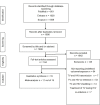Trichomonas vaginalis and HIV infection acquisition: a systematic review and meta-analysis
- PMID: 30341233
- PMCID: PMC6580735
- DOI: 10.1136/sextrans-2018-053713
Trichomonas vaginalis and HIV infection acquisition: a systematic review and meta-analysis
Abstract
Objectives: Trichomoniasis is the most prevalent curable STI globally, with the highest incidence and prevalence in sub-Saharan Africa (sSA). STIs have largely been associated with an increase in HIV acquisition. Our objective was to assess the existing literature available in English regarding the association of Trichomoniasis and HIV-1 acquisition.
Methods: The review protocol was registered at the International Prospective Register of Systematic Reviews (PROSPERO) under number CRD42018082702. We searched MEDLINE, Embase and Scopus databases to collect articles measuring the association of Trichomonas vaginalis infection and HIV acquisition and performed a meta-analysis and qualitative synthesis of the literature.
Results: We identified 1806 unduplicated citations, of which 18 papers and 1 conference abstract were eligible for inclusion in the review after applying our inclusion and exclusion criteria. All the studies included in the systematic review had been carried out in sSA. The articles reported various measures of effects, namely: HRs, rate ratios, risk ratios and ORs. In a meta-analysis restricted to 11 studies reporting HR, individuals infected with T. vaginalis were 1.5 times more likely to acquire HIV compared with individuals not infected with T. vaginalis (95% CI 1.3 to 1.7; p<0.001).
Conclusions: T. vaginalis is an important factor in HIV acquisition especially in sSA where the prevalence of both T. vaginalis and HIV-1 are high. This systematic review and meta-analysis confirms the evidence that infection with T. vaginalis augments HIV acquisition with 50%. Diagnosis and treatment of T. vaginalis infection in both high-risk and low-risk individuals may be a potential tool to reduce new HIV infections.
Trial registration number: CRD42018082702.
Keywords: Africa; HIV; meta-analysis; systematic review; trichomonas.
© Author(s) (or their employer(s)) 2019. Re-use permitted under CC BY-NC. No commercial re-use. See rights and permissions. Published by BMJ.
Conflict of interest statement
Competing interests: None declared.
Figures



References
-
- UNAIDS , 2017. http://www.unaids.org/en/resources/documents/2017/2017_data_book (accessed 06 Jun 2018).
Publication types
MeSH terms
LinkOut - more resources
Full Text Sources
Other Literature Sources
Medical
Research Materials
